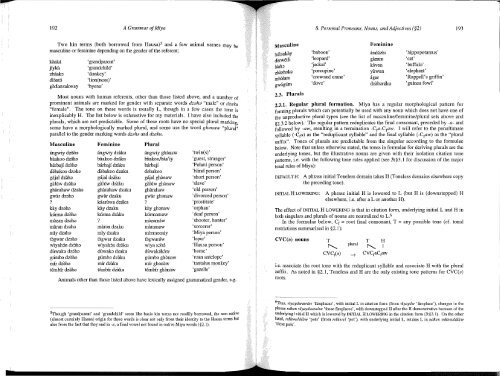A Grammar of Miya - UCLA Department of Linguistics
A Grammar of Miya - UCLA Department of Linguistics
A Grammar of Miya - UCLA Department of Linguistics
You also want an ePaper? Increase the reach of your titles
YUMPU automatically turns print PDFs into web optimized ePapers that Google loves.
192 A <strong>Grammar</strong> <strong>of</strong> <strong>Miya</strong><br />
Two kin terms (both borrowed from Hausa)5 and a few animal names may be<br />
masculine or feminine depending on the gender <strong>of</strong> the referent:<br />
k3aka<br />
jfyka<br />
zMab<br />
dl;\nt;\<br />
gManzakway<br />
'grandparent'<br />
'grandchild'<br />
'donkey'<br />
'lion(ness)'<br />
'hyena'<br />
Most nouns with human referents, other than those listed above, and a number <strong>of</strong><br />
prominent animals are marked for gender with separate words dzaha "male" or dzaku<br />
"female". The tone on these words is usually L, though in a few cases the tone is<br />
inexplicably H. The list below is exhaustive for my materials. I have also included the<br />
plurals, which are not predictable. Some <strong>of</strong> these roots have no special plural marking,<br />
some have a morphologically marked plural, and some use the word ghanaw "plural"<br />
parallel to the gender marking words duha and dzaku.<br />
Masculine Feminine Plural<br />
angwiy dz::'hg angwiy dzaku angwiy gh,maw 'twines)'<br />
b3akoo dz;\hg baakoo dzaku b3akoo!baa'iy 'guest, stranger'<br />
barbajf dzohg barbajf dzaku barbajf 'Fulani person'<br />
d::'bakoo dzghg d::'bakoo dzaku dgbakoo 'blind person'<br />
gajal dz::'hg gajal dzaku gajal gh::'naw 'short person'<br />
ghluw dzohg galuw dzaku ghluw ghOnaw 'slave'<br />
gharahaw dzghg gharahaw dzaku gharahaw 'old person'<br />
gwardzoho gwar dzaku gwar ghonaw 'divorced person'<br />
? klliuilwa dzaku ? 'prostitute'<br />
kay dzohg kay dzaku kay ghgnaw 'orphan'<br />
klirrna dzoho klirmadzaku kurrnamaw 'deaf person'<br />
m::'zan dzghg ? mazamaw 'shooter, hunter'<br />
maron dzoho marondzaku mararnaw 'sorcerer'<br />
mlydzghg miydzaku meemeeniy '<strong>Miya</strong> person'<br />
t::'gwar dzoho t::'gwar dzaku tggwaraw 'leper'<br />
wiyaMn dzoho wiyahon dzaku wiya soM 'Rausa person'<br />
duwako dzoho duwako dzaku duwakakiiw 'horse'<br />
gumbo dzoho gumbodzaku gUmbo ghonaw 'roan antelope'<br />
mir dzohg mfrdzaku mfr ghoniiw 'tantalus monkey'<br />
tembfr dzoho tembfr dzaku tembfr ghonaw 'gazelle'<br />
Animals other than those listed above have lexically assigned grammatical gender, e.g.<br />
5Though 'grandparent' and 'grandchild' seem like basic kin terms not readily borrowed, the non-native<br />
(almost certainly Hausa) origin for these words is clear not only from their identity to the Hausa terms but<br />
also from the fact that they end in -a, a final vowel not found in native <strong>Miya</strong> words (§2.1).<br />
8. Personal Pronouns, Nouns, and Adjectives (§2) 193<br />
Masculine<br />
Feminine<br />
bolonkay<br />
derwetli<br />
liiaho<br />
zhiizhoko<br />
mbolam<br />
gwag11m<br />
'baboon'<br />
'leopard'<br />
'jackal'<br />
'porcupine'<br />
'crowned crane'<br />
'dove'<br />
andazhi<br />
giizam<br />
k::'von<br />
yawun<br />
agar<br />
dzaboraku<br />
'hippopotamus'<br />
'cat'<br />
'buffalo'<br />
'elephant'<br />
'Ruppell's griffin'<br />
'guinea fowl'<br />
2.3. Plurals<br />
2.3.1. Regular plural formation. <strong>Miya</strong> has a regular morphological pattern for<br />
fonning plurals which can potentially be used with any noun which does not have one <strong>of</strong><br />
the unproductive plural types (see the list <strong>of</strong> masculine/feminine/plural sets above and<br />
§2.3.2 below). The regular pattern reduplicates the final consonant, preceded by -a- and<br />
followed by -aw, resulting in a termination -Cra-Craw. I will refer to the penultimate<br />
syllable (-C",) as the "reduplicant syllable" and the final syllable (-C",w) as the "plural<br />
suffix". Tones <strong>of</strong> plurals are predictable from the singular according to the formulae<br />
below. Note that unless otherwise stated, the tones in formulae for deriving plurals are the<br />
underlying tones, but the illustrative nouns are given with their isolation citation tone<br />
patterns, i.e. with the following tone rules applied (see 3:§3.! for discussion <strong>of</strong> the major<br />
tonal rules <strong>of</strong> <strong>Miya</strong>):<br />
DEFAULTH: A phrase initial Toneless domain takes H (Toneless domains elsewhere copy<br />
the preceding tone).<br />
INIT1AL H LOWERING: A phrase initial H is lowered to L (but H is (downstepped) H<br />
elsewhere, i.e. after a L or another H).<br />
The effect <strong>of</strong> INITIAL H LOWERING is that in citation form, underlying initial Land H in<br />
both singulars and plurals <strong>of</strong> nouns are neutralized to L. 6<br />
In the formulae below, C r = root final consonant, T = any possible tone (cf. tonal<br />
restrictions summarized in §2.l):<br />
CVC(.) nouns<br />
plural<br />
i.e. associate the root tone with the reduplicant syllable and associate H with the plural<br />
suffix. As noted in §2.1, Toneless and H are the only existing tone patterns for CVC(a)<br />
roots.<br />
6Thus, vlyayuwawGw 'fireplaces', with initial L in citation form (from viyayuw 'fireplace'), changes in the<br />
phrase ndkan vfyayliwawQ:w 'these fireplaces', with downstepped H after the H demonstrative because <strong>of</strong> the<br />
underlying initial H which is lowered by INITIAL H LOWERING in the citation fann (3:§3.1). On the other<br />
hand, nduwuldlilw 'pots' (from nduwul 'pot'), with underlying initial L, retains L in ndkan nduwuldlilw<br />
'these pots' .
















